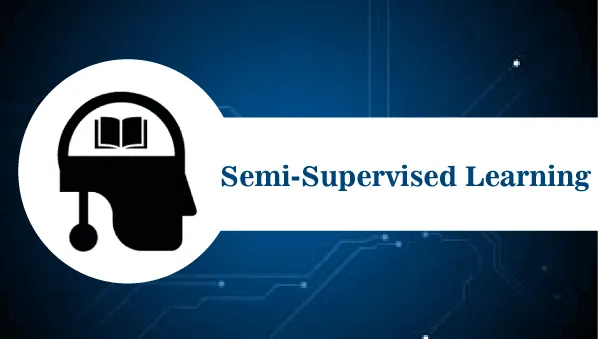Beyond Labels: The Evolution of Learning with Semi-Supervised Techniques
 Saurabh Naik
Saurabh Naik
Introduction:
In the realm of machine learning, we often encounter scenarios where obtaining labeled data for training models is a time-consuming and resource-intensive task. This is where semi-supervised machine learning comes into play, offering a potent approach that combines the best of both supervised and unsupervised techniques. In this article, we'll take a deep dive into the world of semi-supervised learning, exploring its benefits, applications, and key algorithms.

Understanding Semi-Supervised Learning: The Middle Ground
Semi-supervised learning bridges the gap between the labeled and unlabeled data. It harnesses the strengths of both supervised learning (where labeled data guides the model) and unsupervised learning (where the model uncovers hidden patterns without labels). By incorporating limited labeled data and a larger pool of unlabeled data, semi-supervised learning offers a cost-effective and efficient solution for various machine learning challenges.
Benefits and Applications: When Labels Are Scarce
Semi-supervised learning shines in scenarios where obtaining a comprehensive labeled dataset is impractical, expensive, or time-consuming. Some key advantages and applications include:
Text and Natural Language Processing: Semi-supervised techniques excel in sentiment analysis, text classification, and named entity recognition, where labeled data can be scarce due to the need for domain-specific annotations.
Image and Video Analysis: In image recognition and object detection tasks, labeling vast amounts of data is daunting. Semi-supervised approaches leverage unlabeled data to improve model accuracy.
Fraud Detection and Anomaly Detection: In financial and cybersecurity domains, labeled instances of fraudulent behavior are limited. Semi-supervised methods enhance model robustness by learning from both normal and anomalous data.
Healthcare and Medical Imaging: Medical data often requires expert annotations, making labeled samples scarce. Semi-supervised learning aids in disease diagnosis and medical image analysis.
Key Semi-Supervised Learning Algorithms: A Brief Overview

Self-Training: Starts with a small labeled dataset and iteratively expands it by labeling unlabeled instances with the model's predictions. This method can be prone to error propagation.
Co-Training: Splits the unlabeled data into different "views," and two or more models are trained independently on these views. Instances on which the models agree are added to the labeled dataset.
Semi-Supervised Support Vector Machines (S3VM): Extends traditional SVMs to include unlabeled data, incorporating the idea of "margin maximization" into the semi-supervised setting.
Graph-Based Methods: Construct a graph from the data, where nodes represent instances and edges represent similarities. Label propagation or diffusion algorithms then propagate labels through the graph.
Generative Models: Techniques like Generative Adversarial Networks (GANs) and Variational Autoencoders (VAEs) can be used to generate synthetic labeled data, effectively augmenting the labeled dataset.
Challenges and Considerations: Balancing Act
While semi-supervised learning offers promising solutions, it comes with its own set of challenges:
Quality of Labeled Data: The limited labeled data must be accurate and representative to avoid propagating errors.
Assumption of Similarity: Semi-supervised methods often assume that unlabeled data shares similarities with labeled data, which might not always hold.
Algorithm Selection: Choosing the right semi-supervised algorithm depends on the problem and available data.
Conclusion: Leveraging the Power of Unlabeled Data
Semi-supervised machine learning presents an ingenious way to harness the potential of both labeled and unlabeled data. Its applications span diverse domains, offering a lifeline when labeled data is scarce or hard to obtain. By understanding the benefits, challenges, and a few key algorithms, data scientists can unlock insights that traditional supervised approaches might overlook. Embrace the middle ground of semi-supervised learning and unleash the potential of your data like never before.
Subscribe to my newsletter
Read articles from Saurabh Naik directly inside your inbox. Subscribe to the newsletter, and don't miss out.
Written by

Saurabh Naik
Saurabh Naik
🚀 Passionate Data Enthusiast and Problem Solver 🤖 🎓 Education: Bachelor's in Engineering (Information Technology), Vidyalankar Institute of Technology, Mumbai (2021) 👨💻 Professional Experience: Over 2 years in startups and MNCs, honing skills in Data Science, Data Engineering, and problem-solving. Worked with cutting-edge technologies and libraries: Keras, PyTorch, sci-kit learn, DVC, MLflow, OpenAI, Hugging Face, Tensorflow. Proficient in SQL and NoSQL databases: MySQL, Postgres, Cassandra. 📈 Skills Highlights: Data Science: Statistics, Machine Learning, Deep Learning, NLP, Generative AI, Data Analysis, MLOps. Tools & Technologies: Python (modular coding), Git & GitHub, Data Pipelining & Analysis, AWS (Lambda, SQS, Sagemaker, CodePipeline, EC2, ECR, API Gateway), Apache Airflow. Flask, Django and streamlit web frameworks for python. Soft Skills: Critical Thinking, Analytical Problem-solving, Communication, English Proficiency. 💡 Initiatives: Passionate about community engagement; sharing knowledge through accessible technical blogs and linkedin posts. Completed Data Scientist internships at WebEmps and iNeuron Intelligence Pvt Ltd and Ungray Pvt Ltd. successfully. 🌏 Next Chapter: Pursuing a career in Data Science, with a keen interest in broadening horizons through international opportunities. Currently relocating to Australia, eligible for relevant work visas & residence, working with a licensed immigration adviser and actively exploring new opportunities & interviews. 🔗 Let's Connect! Open to collaborations, discussions, and the exciting challenges that data-driven opportunities bring. Reach out for a conversation on Data Science, technology, or potential collaborations! Email: naiksaurabhd@gmail.com